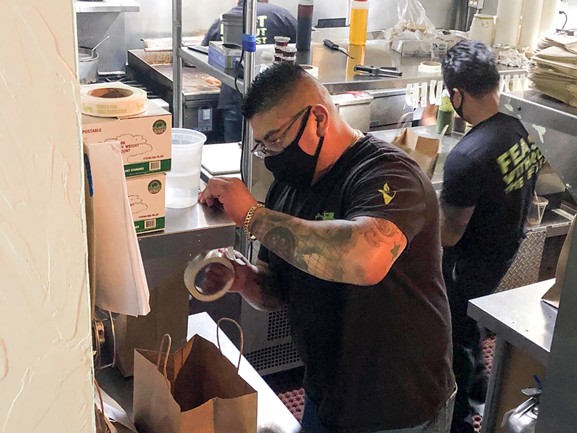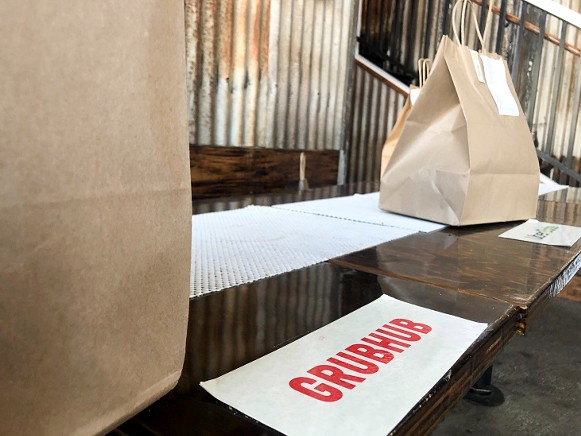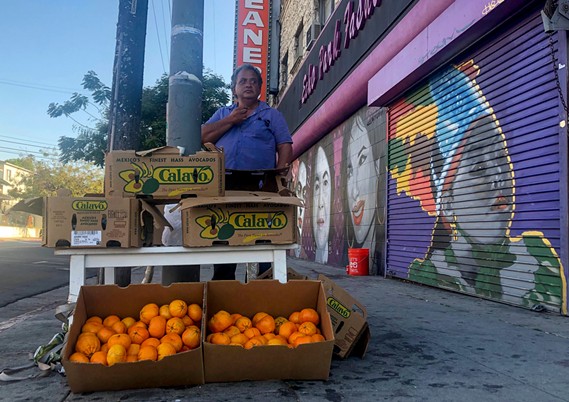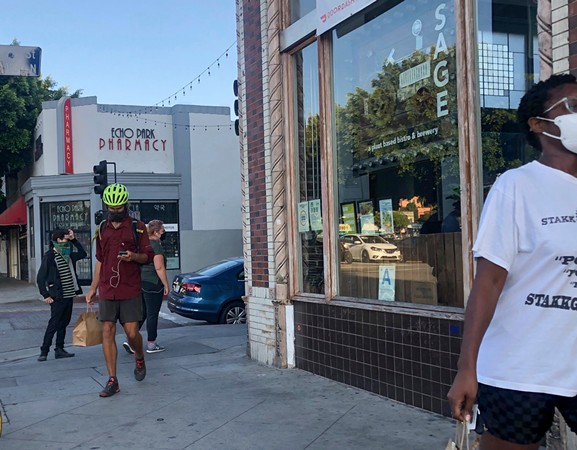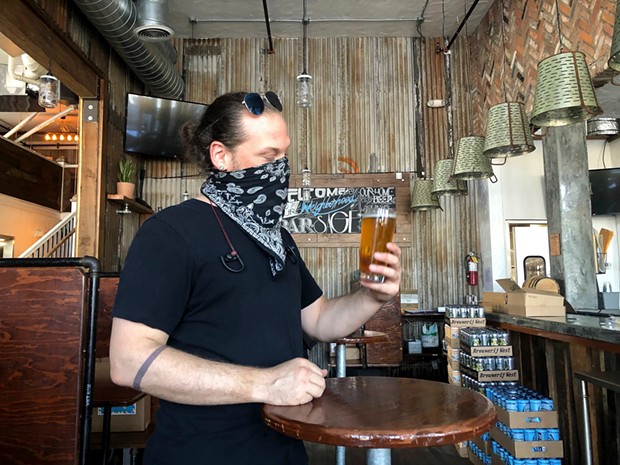Monday, June 1, 2020
The Pandemic's Great Divide: 12 Hours in an L.A. Restaurant
Posted By Nigel Duara/CalMatters on Mon, Jun 1, 2020 at 8:25 AM
Edson Romero maneuvers his black Cadillac Escalade under the early afternoon sun onto Highway 101 in Los Angeles. Behind him is the Boyle Heights home he shares with three siblings. Up ahead is Echo Park, and the job he’s held since the recovery from the last economic crash, back in 2011. He’s dressed in his work uniform: blue jean shorts, running shoes and a black shirt emblazoned with “Sage Plant Based Bistro” in yellow-green lettering.
Romero, 34, needs $3,000 by June 1. His share of rent is $1,700, and he also has to come up with money for alimony and child support, groceries and food for his two bulldogs, Churro and Concha.
Romero was an immigrant success story, a man born in Mexico who forged his own life on this side of the border. He married an American, became a citizen, got a job as a dishwasher, brought his family members up to Los Angeles one at a time and sent money back to his parents. He worked his way up to the position of server in what was a thriving vegan restaurant.
Then the coronavirus pandemic hit, and the government response began dismantling the economic undergirdings of this city, piece by piece.
Collectively, Romero and his three siblings earn about one-tenth of what they did before the pandemic. All of them work at one of four Sage Bistro restaurants in the Los Angeles area.
“We got to wait and see, maybe look [for] other jobs,” said Romero, who estimates, pre-pandemic, he earned up to $1,500 per week before taxes. “But there’s no jobs.”
The coronavirus pandemic has exposed the economic vulnerabilities in every link of the food industry’s chain from field to table, from the workers who harvest onions and process meat to those who lay out soup spoons and clean up food scraps.
The disruption is particularly visible at restaurants, which were ordered statewide to close to dine-in customers on March 17. The three dozen employees of the Sage Bistro in Echo Park represent every segment of the pre-pandemic economy, from the dishwashers earning $14.25 per hour to the owner, whose receipts have dropped by half.
Like millions of Californians, Romero and his family and his boss and co-workers are all economic victims of the pandemic.
A family business
On a Thursday afternoon earlier this month, Romero pulls off the highway and rounds Echo Park Lake, the namesake of this neighborhood which flourished with joggers and shoppers and eloteros and loiterers before the coronavirus pandemic. Today, in the early afternoon, the streets are nearly empty.
Romero parks a block away from the Sage Bistro and walks through glass double doors affixed with paper signs asking customers to wear a mask and keep six feet from each other.
The empty tables and booths are a mocking reminder that, just a little more than two months ago, the restaurant would be full and at each of those tables would be a tip.
Sage Bistro is only open for take-out and delivery. Some customers tip, most don’t, and certainly not 15 percent of the entire bill. Romero now earns minimum wage, $14.25 per hour, but is lucky to draw four full eight-hour shifts each week.
The only citizen among his siblings, he’s the only one who can collect a federal stimulus check, and he has applied for unemployment for the hours at work he’s lost.
Restaurants in other California counties are opening up, but in Los Angeles County, which is a hotspot for the virus, they are still limited to carryout and online delivery services, which take a percentage of each order, capped by the Los Angeles City Council at 15 percent.
Romero’s older sister, Paula, 44, is already at work in the kitchen, where she is the pastry chef. One of his younger brothers will work a 4 p.m. to 10 p.m. shift as a food runner.
Sage Bistro, which just opened its fourth Los Angeles location, is a family business. That’s often literal. Along with all of the Romeros who work there, owner Mollie Englehart’s father has his own Los Angeles vegan restaurant chain (“I’m not competing with him, I’m beating him,” she says with a laugh). Englehart met her husband when he started work in the back of the house as an undocumented dishwasher. Now he’s the head chef.
But the familial ties that bind this 20-table neighborhood restaurant are fraying during the pandemic as mom-and-pop restaurants across the state and nation face extinction.
‘I didn’t know it would be like this’
Mollie Englehart, 40, Sage’s owner, hands off her six-month-old son to her husband and settles into a booth near the restaurant’s rear window. So far, she is not in any immediate financial danger. But she’s heard the desperate calls from employees she put on leave at the outset of the pandemic, and she feels helpless.
“I’d like to bring everybody back to work, but I can’t have more than ten people in one place,” Englehart said.
No one working at the restaurant has been infected with the coronavirus, as far as they know.
“I understand that if you lost someone to COVID, what I’m about to say is going to sound terrible, but we’ve flattened the curve. We’ve more than flattened the curve,” Englehart said. “What is the endgame?”
Englehart has taken all the steps she can think of to keep her restaurants going. She offers produce boxes for sale, using the vegetables grown on her farm. She received a Paycheck Protection Plan loan equivalent to two-and-a-half times the restaurant’s average monthly payroll. She applied for all four of her restaurants and her farm, but only two restaurants were approved.
April and May receipts are down 50 percent from February, Englehart said, her rent is ten times more than when she first opened nine years ago, The immediate future is not exactly promising: A Slate survey of 6,000 people found that 73 percent would not eat at an indoor restaurant.
Nationally, 11 million people were employed by restaurants before the pandemic. About half – more than 5.5 million – have lost their jobs, according to industry and government estimates. More than four in ten restaurants have closed, and two-thirds of restaurant workers nationally are out of work.
The California Restaurant Association predicts that one in four restaurants won’t survive the pandemic in an industry that employs 1.4 million people in the state.
The conditions of the Paycheck Protection Program are especially difficult for restaurants.
The way the PPP works, small businesses are granted the loan based on their average monthly payroll from 2019. Only 25 percent can be spent on non-payroll expenses. To receive loan forgiveness, the businesses must keep all full time employees or rehire them by June 30.
But restaurants don’t operate like other businesses, especially during a pandemic.
Sage can’t simply reopen its doors and hire back its full staff; municipal guidelines dictate that tables be spaced six feet apart. How, Englehart asks, is she supposed to rehire her full staff when perhaps only a quarter of her restaurant can open?
“I only have 18 months to pay [the loan] back, and I have no idea what the next [two years] are going to look like,” Englehart said. “The bank’s getting 6 percent on each of these loans. So now tell me who’s winning.”
A bill introduced by U.S. Rep. Earl Blumenauer, a Democrat from Oregon, would offer $120 billion to independent restaurants, without the payback requirement.
Englehart also worries that, along with the drop in sales, something essential about Sage Bistro will be lost after the pandemic.
“What makes my restaurant cool is a dimly-lit, tight-packed, very full place,” Englehart said. “People are drinking, people are at small tables eating, talking to the table next to them. That is my restaurant.
“And now they want us to open at 25 percent? What does that look like?”
A neighborhood’s rise and fall
That’s a common question among Los Angeles restaurateurs, and there are no simple answers. In Echo Park, the stakes are particularly high.
A small neighborhood north of downtown and east of glitzier West Los Angeles, Echo Park was until the mid-2010s a battleground for six gangs competing for 3.8 miles of territory. But the gang wars settled and the older storefronts that defined the neighborhood — pawn shops, liquor stores, dollar stores — started losing ground to comic book shops and vintage stores. Older Hispanic and Filipino families moved east, and younger people employed in downtown Los Angeles moved in.
The cheap real estate drew ambitious chefs, who opened ambitious restaurants. The area was just beginning to earn its bona fides as a food destination.
“The choices are vast, from taco trucks and new-wave taquerias to vegan and vegetarian spots, great coffee shops, diners, dive bars and one of L.A.’s longest-running French restaurants, Taix,” wrote Los Angeles Times restaurant critic S. Irene Virbila in 2014.
“Echo Park’s best dining days may well be happening this very moment,” EaterLA raved in April 2019.
Today, shuttered storefronts proliferate. Liquor stores and dollar stores — the businesses of the old Echo Park — are still open, but the bars and restaurants that propped up this area remain either closed or open for limited hours.
“This is a neighborhood where we tolerate homeless people who are our neighborhood homeless people, we don’t call the cops on them,” Englehart said. “This is a neighborhood where the [older gang members] sit out on the corner all day, there’s no six feet of [space] walking on the sidewalk.
“You got the mamacitas selling fruit and selling nopales and selling bread and selling elotes. What are we doing to the neighborhood? What’s going to be here after?”
It’s a concern shared by other independent restaurants in Echo Park.
“We don’t want to end up seeing a bunch of chain restaurants moving in because they have the infrastructure,” said Courtney Kaplan, who owns the izakaya Tsubaki. “You’ll get that cookie cutter-style nothing. The reason people enjoy Echo Park is because it’s unique.”
And it’s the independent restaurants that are most at risk.
“All of these mom-and-pop shops that we love, 60 percent are probably going to go away,” said Kristel Arabian, founder of Los Angeles-based Kitchen Culture Recruiting and a former chef. “And what’s going to come into its place are [people] making pizza and money, and the pizza will taste like cardboard.”
Tight quarters during a pandemic
It’s 10 minutes into the 2 p.m. shift, when the lunch crush would usually arrive. Today, there are sometimes one or two people waiting outside, but the restaurant is nearly empty. Romero stands near the kitchen entrance, folding take-out boxes and carrying them to front.
Social distancing is a fantasy in most of the restaurant business. Sage’s tight kitchen, about 300 square feet, has five or six people working around a massive center island, moving from the saute pans on gas burners to bubbling pots of mole to the prep station for vegetables.
Walkways are dangerous places to stand when Romero or another server come barreling out of the kitchen with a to-go order in each hand. The dinner rush, though diminished, is still a frantic scene of splashes, sizzles, shouts and, ultimately, submission to a ticking clock that says every order is late before the next one begins.
And customers are doing a fairly rotten job of distancing themselves. Despite signs on the door asking people to keep six feet apart and wait on the sidewalk, most stroll in — albeit in masks — and hover in clumps.
“Can’t just kick everybody out even if they’re not following the [social distancing] rules,” Romero said.
Is he worried about getting sick?
“I’m worried every day, man.”
Romero moves through the restaurant with an experienced grace belied by his beefy frame, working the register, greeting customers, dealing with cleanups, pushing a barrel of veggie scraps down the lumpy sidewalk to a waiting van.
Sweating and out of breath, he takes a moment to catch his breath.
Since the pandemic shutdown, business is down about 50 percent at the Sage restaurants, which have to rely on takeout and delivery services.
It’s time for the dinner rush.
Romero stands by the entrance to the kitchen and carries bags of food to the take-out table, marked with signs for Uber Eats, Grubhub, Postmates and Carry-Out.
At least 32 people pick up orders between 6 p.m. and 8 p.m., plus more bags of food waiting for delivery drivers. Most of the orders are for burritos, pizzas and bowls. They are beginning to pile up.
A customer takes a call and steps outside while waiting for his order. Romero has to chase him down the street to hand him a burrito. He is unable to maintain a 6-foot distance while doing so.
“You try to make everything easy, but…” he trails off, shrugging.
Why didn’t you just toss it to him from 6 feet away?
“Nah, man. We don’t throw food at people.”
A microcosm of inequality
In the back office, floor manager and Echo Park native Ana Reza, 30, is trying to figure out schedules for the few employees still working. She’s the sole provider for her mother, sister and her three children, the eldest of whom is 10.
When she calls the restaurant’s servers to see if they will return to work, she is most often told no.
“Now that we’re getting a little bit busier, we’re trying to get people to come into work, but some people don’t want to bother because it’s not worth it,” Reza said. “They’d rather stick with the unemployment.”
Restaurants function as a microcosm of American inequality. The pandemic has only deepened the divisions between managers who kept their jobs and entry-level employees who didn’t, between those who have family money to turn to and those who don’t, between longtime residents with a network of job leads and recent arrivals who find themselves relatively alone.
“As a recruiter, I’ve been noticing in the workforce that there is an inequality around privilege,” Arabian said, “around who gets to stay home and ‘enjoy’ their quarantine and who’s out there harvesting food, cooking food, delivering food.”
The divide is most pronounced between those who are documented and those who aren’t. At Sage, most servers collecting unemployment say their semi-weekly checks exceed what they would make in the restaurant. On the other hand, undocumented workers have begged Reza to come back.
“The thing that we’ve seen is that undocumented people do want more hours,” Reza said. “I’ve even had people offer to come and clean if we don’t have our regular cleaning people, which is completely opposite from our employees who are documented.”
That’s true in restaurants across the country, and especially in California, where 6 percent of the state is estimated to be undocumented. According to the Pew Research Center, undocumented labor comprises about 9 percent of the hospitality industry workforce, less than construction or agriculture, but among the highest number of undocumented workers in any industry.
CalMatters requested to speak with undocumented workers at Sage Bistro and was given access to the kitchen, but no one working identified themselves as undocumented or discussed their experiences.
Restaurants are most people’s first jobs, Arabian said, and they are among the most diverse industries in the country, with high percentages of single parents, people of color, former prisoners and the undocumented.
“When people can’t go somewhere else,” she said, “they come to hospitality.”
Beer and survival
The bar is polished wood, shiny metal and completely empty but for two employees, a bartender and an assistant brewer, who are deep in conversation about survival.
“It took five weeks to get unemployment,” said Danny Randerson, 41, who moved from New York to Los Angeles in January. “Something I misfiled three years ago, I don’t know.”
“That sucks,” said assistant brewer Dylan Powers, 40, hoisting the brewery’s first batch of a new habanero pilsner. “I’m down to 12-15 hours a month, plus the unemployment.”
“You get a check with Trump’s name on it yet?” Randerson asked.
“Nah. Everyone’s doing this,” Powers said, raking his nails across the bar. “Just holding on.”
Randerson replied: “I’ll f—ing take it, man.”
The May rent came due, and Randerson told his landlord he could only pay half. He plans to do the same in June.
Now, he’s down to two to three shifts each week paying $14.25 per hour, making the occasional to-go cocktail and helping with the brewery business. There are few, if any, tips.
“I’m grateful for the hours I get,” Randerson said. “But it’s not like it’s enough. And the [half of rent] I owe is still going to need to get paid later. That doesn’t go away.”
With the fewest shifts among the restaurant workers and virtually no connections, Randerson and his wife find themselves adrift in a new city.
The dinner rush subsides and Romero begins punching his last few orders onto a screen at his station at the kitchen’s entrance. He claps a food runner on the back and weaves his way through the five customers lined up inside.
In three minutes, he will be free, back in his car, rumbling east to Boyle Heights. He might soon have to leave the home he can no longer afford and move farther east, to cheaper housing, chased by the pandemic and the foundations of a life crumbling beneath his feet.
This article is part of The California Divide, a collaboration among newsrooms examining income inequity and economic survival in California.
Romero, 34, needs $3,000 by June 1. His share of rent is $1,700, and he also has to come up with money for alimony and child support, groceries and food for his two bulldogs, Churro and Concha.
Romero was an immigrant success story, a man born in Mexico who forged his own life on this side of the border. He married an American, became a citizen, got a job as a dishwasher, brought his family members up to Los Angeles one at a time and sent money back to his parents. He worked his way up to the position of server in what was a thriving vegan restaurant.
Then the coronavirus pandemic hit, and the government response began dismantling the economic undergirdings of this city, piece by piece.
Collectively, Romero and his three siblings earn about one-tenth of what they did before the pandemic. All of them work at one of four Sage Bistro restaurants in the Los Angeles area.
“We got to wait and see, maybe look [for] other jobs,” said Romero, who estimates, pre-pandemic, he earned up to $1,500 per week before taxes. “But there’s no jobs.”
The coronavirus pandemic has exposed the economic vulnerabilities in every link of the food industry’s chain from field to table, from the workers who harvest onions and process meat to those who lay out soup spoons and clean up food scraps.
The disruption is particularly visible at restaurants, which were ordered statewide to close to dine-in customers on March 17. The three dozen employees of the Sage Bistro in Echo Park represent every segment of the pre-pandemic economy, from the dishwashers earning $14.25 per hour to the owner, whose receipts have dropped by half.
Like millions of Californians, Romero and his family and his boss and co-workers are all economic victims of the pandemic.
A family business
On a Thursday afternoon earlier this month, Romero pulls off the highway and rounds Echo Park Lake, the namesake of this neighborhood which flourished with joggers and shoppers and eloteros and loiterers before the coronavirus pandemic. Today, in the early afternoon, the streets are nearly empty.
Romero parks a block away from the Sage Bistro and walks through glass double doors affixed with paper signs asking customers to wear a mask and keep six feet from each other.
The empty tables and booths are a mocking reminder that, just a little more than two months ago, the restaurant would be full and at each of those tables would be a tip.
Sage Bistro is only open for take-out and delivery. Some customers tip, most don’t, and certainly not 15 percent of the entire bill. Romero now earns minimum wage, $14.25 per hour, but is lucky to draw four full eight-hour shifts each week.
The only citizen among his siblings, he’s the only one who can collect a federal stimulus check, and he has applied for unemployment for the hours at work he’s lost.
Restaurants in other California counties are opening up, but in Los Angeles County, which is a hotspot for the virus, they are still limited to carryout and online delivery services, which take a percentage of each order, capped by the Los Angeles City Council at 15 percent.
Romero’s older sister, Paula, 44, is already at work in the kitchen, where she is the pastry chef. One of his younger brothers will work a 4 p.m. to 10 p.m. shift as a food runner.
Sage Bistro, which just opened its fourth Los Angeles location, is a family business. That’s often literal. Along with all of the Romeros who work there, owner Mollie Englehart’s father has his own Los Angeles vegan restaurant chain (“I’m not competing with him, I’m beating him,” she says with a laugh). Englehart met her husband when he started work in the back of the house as an undocumented dishwasher. Now he’s the head chef.
But the familial ties that bind this 20-table neighborhood restaurant are fraying during the pandemic as mom-and-pop restaurants across the state and nation face extinction.
‘I didn’t know it would be like this’
Mollie Englehart, 40, Sage’s owner, hands off her six-month-old son to her husband and settles into a booth near the restaurant’s rear window. So far, she is not in any immediate financial danger. But she’s heard the desperate calls from employees she put on leave at the outset of the pandemic, and she feels helpless.
“I’d like to bring everybody back to work, but I can’t have more than ten people in one place,” Englehart said.
No one working at the restaurant has been infected with the coronavirus, as far as they know.
“I understand that if you lost someone to COVID, what I’m about to say is going to sound terrible, but we’ve flattened the curve. We’ve more than flattened the curve,” Englehart said. “What is the endgame?”
Englehart has taken all the steps she can think of to keep her restaurants going. She offers produce boxes for sale, using the vegetables grown on her farm. She received a Paycheck Protection Plan loan equivalent to two-and-a-half times the restaurant’s average monthly payroll. She applied for all four of her restaurants and her farm, but only two restaurants were approved.
April and May receipts are down 50 percent from February, Englehart said, her rent is ten times more than when she first opened nine years ago, The immediate future is not exactly promising: A Slate survey of 6,000 people found that 73 percent would not eat at an indoor restaurant.
Nationally, 11 million people were employed by restaurants before the pandemic. About half – more than 5.5 million – have lost their jobs, according to industry and government estimates. More than four in ten restaurants have closed, and two-thirds of restaurant workers nationally are out of work.
The California Restaurant Association predicts that one in four restaurants won’t survive the pandemic in an industry that employs 1.4 million people in the state.
The conditions of the Paycheck Protection Program are especially difficult for restaurants.
The way the PPP works, small businesses are granted the loan based on their average monthly payroll from 2019. Only 25 percent can be spent on non-payroll expenses. To receive loan forgiveness, the businesses must keep all full time employees or rehire them by June 30.
But restaurants don’t operate like other businesses, especially during a pandemic.
Sage can’t simply reopen its doors and hire back its full staff; municipal guidelines dictate that tables be spaced six feet apart. How, Englehart asks, is she supposed to rehire her full staff when perhaps only a quarter of her restaurant can open?
“I only have 18 months to pay [the loan] back, and I have no idea what the next [two years] are going to look like,” Englehart said. “The bank’s getting 6 percent on each of these loans. So now tell me who’s winning.”
A bill introduced by U.S. Rep. Earl Blumenauer, a Democrat from Oregon, would offer $120 billion to independent restaurants, without the payback requirement.
Englehart also worries that, along with the drop in sales, something essential about Sage Bistro will be lost after the pandemic.
“What makes my restaurant cool is a dimly-lit, tight-packed, very full place,” Englehart said. “People are drinking, people are at small tables eating, talking to the table next to them. That is my restaurant.
“And now they want us to open at 25 percent? What does that look like?”
A neighborhood’s rise and fall
That’s a common question among Los Angeles restaurateurs, and there are no simple answers. In Echo Park, the stakes are particularly high.
A small neighborhood north of downtown and east of glitzier West Los Angeles, Echo Park was until the mid-2010s a battleground for six gangs competing for 3.8 miles of territory. But the gang wars settled and the older storefronts that defined the neighborhood — pawn shops, liquor stores, dollar stores — started losing ground to comic book shops and vintage stores. Older Hispanic and Filipino families moved east, and younger people employed in downtown Los Angeles moved in.
The cheap real estate drew ambitious chefs, who opened ambitious restaurants. The area was just beginning to earn its bona fides as a food destination.
“The choices are vast, from taco trucks and new-wave taquerias to vegan and vegetarian spots, great coffee shops, diners, dive bars and one of L.A.’s longest-running French restaurants, Taix,” wrote Los Angeles Times restaurant critic S. Irene Virbila in 2014.
“Echo Park’s best dining days may well be happening this very moment,” EaterLA raved in April 2019.
Today, shuttered storefronts proliferate. Liquor stores and dollar stores — the businesses of the old Echo Park — are still open, but the bars and restaurants that propped up this area remain either closed or open for limited hours.
“This is a neighborhood where we tolerate homeless people who are our neighborhood homeless people, we don’t call the cops on them,” Englehart said. “This is a neighborhood where the [older gang members] sit out on the corner all day, there’s no six feet of [space] walking on the sidewalk.
“You got the mamacitas selling fruit and selling nopales and selling bread and selling elotes. What are we doing to the neighborhood? What’s going to be here after?”
It’s a concern shared by other independent restaurants in Echo Park.
“We don’t want to end up seeing a bunch of chain restaurants moving in because they have the infrastructure,” said Courtney Kaplan, who owns the izakaya Tsubaki. “You’ll get that cookie cutter-style nothing. The reason people enjoy Echo Park is because it’s unique.”
And it’s the independent restaurants that are most at risk.
“All of these mom-and-pop shops that we love, 60 percent are probably going to go away,” said Kristel Arabian, founder of Los Angeles-based Kitchen Culture Recruiting and a former chef. “And what’s going to come into its place are [people] making pizza and money, and the pizza will taste like cardboard.”
Tight quarters during a pandemic
It’s 10 minutes into the 2 p.m. shift, when the lunch crush would usually arrive. Today, there are sometimes one or two people waiting outside, but the restaurant is nearly empty. Romero stands near the kitchen entrance, folding take-out boxes and carrying them to front.
Social distancing is a fantasy in most of the restaurant business. Sage’s tight kitchen, about 300 square feet, has five or six people working around a massive center island, moving from the saute pans on gas burners to bubbling pots of mole to the prep station for vegetables.
Walkways are dangerous places to stand when Romero or another server come barreling out of the kitchen with a to-go order in each hand. The dinner rush, though diminished, is still a frantic scene of splashes, sizzles, shouts and, ultimately, submission to a ticking clock that says every order is late before the next one begins.
And customers are doing a fairly rotten job of distancing themselves. Despite signs on the door asking people to keep six feet apart and wait on the sidewalk, most stroll in — albeit in masks — and hover in clumps.
“Can’t just kick everybody out even if they’re not following the [social distancing] rules,” Romero said.
Is he worried about getting sick?
“I’m worried every day, man.”
Romero moves through the restaurant with an experienced grace belied by his beefy frame, working the register, greeting customers, dealing with cleanups, pushing a barrel of veggie scraps down the lumpy sidewalk to a waiting van.
Sweating and out of breath, he takes a moment to catch his breath.
Since the pandemic shutdown, business is down about 50 percent at the Sage restaurants, which have to rely on takeout and delivery services.
It’s time for the dinner rush.
Romero stands by the entrance to the kitchen and carries bags of food to the take-out table, marked with signs for Uber Eats, Grubhub, Postmates and Carry-Out.
At least 32 people pick up orders between 6 p.m. and 8 p.m., plus more bags of food waiting for delivery drivers. Most of the orders are for burritos, pizzas and bowls. They are beginning to pile up.
A customer takes a call and steps outside while waiting for his order. Romero has to chase him down the street to hand him a burrito. He is unable to maintain a 6-foot distance while doing so.
“You try to make everything easy, but…” he trails off, shrugging.
Why didn’t you just toss it to him from 6 feet away?
“Nah, man. We don’t throw food at people.”
A microcosm of inequality
In the back office, floor manager and Echo Park native Ana Reza, 30, is trying to figure out schedules for the few employees still working. She’s the sole provider for her mother, sister and her three children, the eldest of whom is 10.
When she calls the restaurant’s servers to see if they will return to work, she is most often told no.
“Now that we’re getting a little bit busier, we’re trying to get people to come into work, but some people don’t want to bother because it’s not worth it,” Reza said. “They’d rather stick with the unemployment.”
Restaurants function as a microcosm of American inequality. The pandemic has only deepened the divisions between managers who kept their jobs and entry-level employees who didn’t, between those who have family money to turn to and those who don’t, between longtime residents with a network of job leads and recent arrivals who find themselves relatively alone.
“As a recruiter, I’ve been noticing in the workforce that there is an inequality around privilege,” Arabian said, “around who gets to stay home and ‘enjoy’ their quarantine and who’s out there harvesting food, cooking food, delivering food.”
The divide is most pronounced between those who are documented and those who aren’t. At Sage, most servers collecting unemployment say their semi-weekly checks exceed what they would make in the restaurant. On the other hand, undocumented workers have begged Reza to come back.
“The thing that we’ve seen is that undocumented people do want more hours,” Reza said. “I’ve even had people offer to come and clean if we don’t have our regular cleaning people, which is completely opposite from our employees who are documented.”
That’s true in restaurants across the country, and especially in California, where 6 percent of the state is estimated to be undocumented. According to the Pew Research Center, undocumented labor comprises about 9 percent of the hospitality industry workforce, less than construction or agriculture, but among the highest number of undocumented workers in any industry.
CalMatters requested to speak with undocumented workers at Sage Bistro and was given access to the kitchen, but no one working identified themselves as undocumented or discussed their experiences.
Restaurants are most people’s first jobs, Arabian said, and they are among the most diverse industries in the country, with high percentages of single parents, people of color, former prisoners and the undocumented.
“When people can’t go somewhere else,” she said, “they come to hospitality.”
Beer and survival
The bar is polished wood, shiny metal and completely empty but for two employees, a bartender and an assistant brewer, who are deep in conversation about survival.
“It took five weeks to get unemployment,” said Danny Randerson, 41, who moved from New York to Los Angeles in January. “Something I misfiled three years ago, I don’t know.”
“That sucks,” said assistant brewer Dylan Powers, 40, hoisting the brewery’s first batch of a new habanero pilsner. “I’m down to 12-15 hours a month, plus the unemployment.”
“You get a check with Trump’s name on it yet?” Randerson asked.
“Nah. Everyone’s doing this,” Powers said, raking his nails across the bar. “Just holding on.”
Randerson replied: “I’ll f—ing take it, man.”
The May rent came due, and Randerson told his landlord he could only pay half. He plans to do the same in June.
Now, he’s down to two to three shifts each week paying $14.25 per hour, making the occasional to-go cocktail and helping with the brewery business. There are few, if any, tips.
“I’m grateful for the hours I get,” Randerson said. “But it’s not like it’s enough. And the [half of rent] I owe is still going to need to get paid later. That doesn’t go away.”
With the fewest shifts among the restaurant workers and virtually no connections, Randerson and his wife find themselves adrift in a new city.
The dinner rush subsides and Romero begins punching his last few orders onto a screen at his station at the kitchen’s entrance. He claps a food runner on the back and weaves his way through the five customers lined up inside.
In three minutes, he will be free, back in his car, rumbling east to Boyle Heights. He might soon have to leave the home he can no longer afford and move farther east, to cheaper housing, chased by the pandemic and the foundations of a life crumbling beneath his feet.
This article is part of The California Divide, a collaboration among newsrooms examining income inequity and economic survival in California.
Speaking of...
-

Il Forno in Fortuna
Jul 8, 2024 -
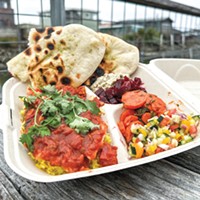
Falafelove Blooms in King Salmon
Jul 4, 2024 -
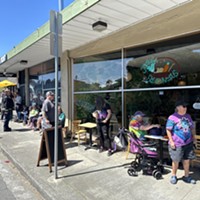
Last Call for Soup at Japhy's
May 23, 2024 - More »

